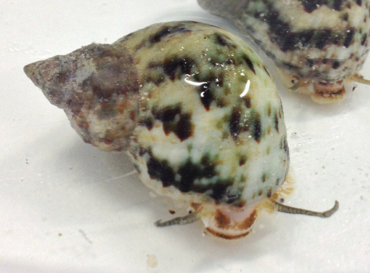
Members of the family of turbans have bulbous, turban like coiled shells (Kuiter, 2003) Their shells are think with an iridescent interior and thick shelly operculum. They are also top shaped (Sprung, 2001).
 
Photo of Turbo undulatus showing their top-shaped shell
Their medium to large solid turbinate shells often have spiral chords, radial rids, rounded whorls, nacreous interior and smooth columella. The solid shells of Turbo undulatus is usually wider than high and covered with a thin, brown periostracum. The aperture is circular with a thin and simple outer lip. Their external colouration consists of zigzag axial streaks of white and dark green, with umbilical area and columella white (Beechey, 2012).
The think shelly, circular operculum of Turbo undulatus is solid and calcareous. Although other Turban snails may have a colourful operculum (Potter and Short, 1987), the Turbo undulatus have a single colored, externally white and internally brown operculum. The operculum is internally flat and have marginal flange on its external. A central dome is often present as well (Beechey, 2012). The operculum used to close its opening is often nicely marked and referred to as a cat's-eye and sometimes is used for making buttons (Kuiter, 2003)

Picture of the pale yellowish operculum of Turbo undulatus
Another prominent features of Turbo undulatus is their long paired cephalic tentacles on their head. These tentacles are long elongate projections of the body. Their tentacles is involved in chemoreception and may include other roles such as photoreception and chemoreception (Ruppert, Fox and Barnes, 2003).

Picture showing the tentacles of Turbo undulatus
The eyes of Turbo undulatus is rather small but conspicuous when viewed under a microscope. They have one pair of eyes which function as photoreceptive organs on the head. It is located on projections (ommatophores or tentacles) and consists of cornea, retina and lens (Stachowitsch, 1992).
|